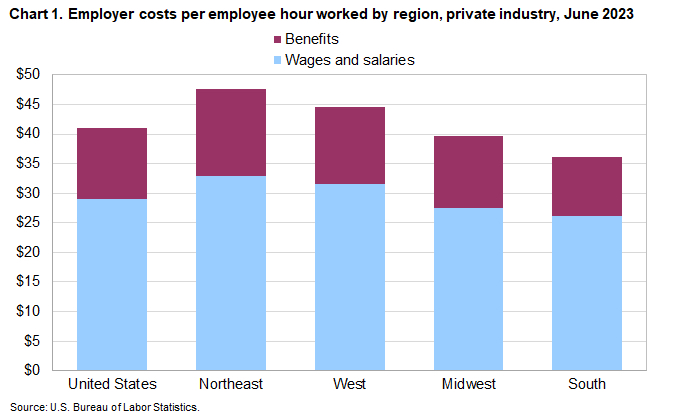Effective management of your payroll schedule can have a tremendous impact on your organization’s bottom line. After all, payroll is typically the most significant expense for a business, and careful budget planning is necessary to ensure operational efficiency, profitability, and compliance. When your payroll schedule is effective, employees are paid accurately, on time, and within the company’s budget. In this blog post, we’ll explore the relationship between payroll scheduling and budgeting and how they can work to ensure financial stability for a business.
Impact of Payroll Scheduling on Budgeting
Your payroll budget reveals what costs you should expect from payroll. Since payroll consumes a large percentage of the total company budget, failing to manage it carefully can be disastrous — especially since employee payroll costs range from 1.25 to 1.4 times the sum of salaries.
The Bureau of Labor Statistics calculated the employer costs per employee hour worked by region in the U.S. in 2023, which varied from $40 to $48.

Ineffective payroll scheduling can affect your cash flow through unforeseen payroll overspending. Here are some ways payroll management can affect your business:
1. Consistency and Predictability
Establishing a predictable payroll schedule enables better forecasting and accurate budgeting, allowing a business to plan ahead for labor costs. When a business knows when to expect payroll expenses and how much they’ll be, it can adjust labor costs in advance. By forecasting periods with higher payroll costs, organizations can maintain financial stability and prepare the necessary funding to meet payroll obligations.
2. Overtime and Time Off
Surprises aren’t good for budgets — no business wants to find itself facing the results of higher-than-anticipated overtime or vacation costs. With the average American employee working around four hours of overtime per week, factoring in overtime and time off costs during budget planning ensures that a business allocates the appropriate funds for labor.
3. Compliance and Liability
Accurate payroll scheduling is critical to ensuring compliance with regulations — such as minimum wages, tax withholding, and reporting — and avoiding any resultant penalties and legal disputes.
Companies hiring salaried employees along with contractors or on-demand workers can find it challenging to comply with the regulations for all of them. Payroll scheduling software prevents compliance mistakes by automatically calculating the taxes to withhold and delivering the payments on time.
How to Fix Payroll Scheduling
Without a well-considered payroll strategy, you can easily find your company facing unnecessary costs, inefficiencies, and instability. Now that we know more about how payroll scheduling can impact your budget, we can explore how to optimize the payroll budget and scheduling. Follow these tips:
1. Track and Analyze Labor Costs
One of the main steps in optimizing the payroll budget is implementing robust labor cost tracking and analysis systems. Closely monitor and analyze payroll and budget data so you can optimize labor allocation and identify cost-saving opportunities.
By tracking labor costs, you can:
- Improve employee productivity: Understand how labor hours correlate with productivity and ensure you have the right number of staff for the required tasks.
- Identify inefficiencies: Pinpoint areas where labor costs are unnecessarily high. This may help you with resource allocation.
- Leverage forecasting: An efficient system can use historical data to forecast future staffing needs.
- Detect cost-saving opportunities: Data may also show where you can reduce costs without compromising productivity.
2. Develop Flexible and Scalable Budget Plans
Creating flexible budget plans that can adapt to changing payroll needs enables businesses to adjust labor costs according to fluctuating demands or economic conditions. Here’s how to accomplish this:
- Prepare for contingencies: Assign a portion of your budget for unexpected payroll expenses.
- Allocate resources: A flexible budget will allow you to allocate resources as needed.
- Plan for different scenarios: When you have visibility over your budget, you can shift resources as needed and navigate through slow periods without sacrificing your bottom line.
3. Engage in Proactive Risk Management
There are risks inherent to payroll management: fraud, misclassification, data loss or insecurity, and compliance errors, to name a few. A payroll budget helps you to be proactive on risk management. Conducting regular audits and reviews of payroll processes and procedures reduces the risk of errors, fraud, and liability, helping to ensure financial stability for your business.
Steps you can take to reduce risk:
- Compliance checks: Ensure payroll practices comply with relevant labor laws and regulations.
- Regular audits: Rotating audits of your payroll processes can help you identify vulnerabilities, discrepancies, errors, or fraud.
- Employee training: Train your staff on payroll processes, compliance requirements, and ethical behavior.
How Nowsta Helps Achieve Payroll Scheduling Within Your Budget
Effective payroll scheduling and budget management are crucial for a business to maintain financial stability and sustainability. Businesses can optimize their labor budget and ensure long-term success by establishing consistent and predictable payroll schedules, incorporating labor cost tracking and analysis, and conducting regular risk management practices.
Nowsta is a perfect example of an effective, all-in-one staff management platform. It centralizes processes in an online dashboard that gives you 360° visibility. With Nowsta, you have staff management covered, from hiring to payroll.
You can create a payroll budget and schedule payments with ease for all types of workers — Nowsta is the only staff management solution that handles both on-demand and salaried workers.
Nowsta’s features include centralized reporting and tracking, automated staffing, payroll scheduling, intelligent time-tracking, and more. You can quickly submit work orders and oversee operations from start to finish, including invoicing.
Learn why Nowsta is the simplest and most comprehensive solution to scheduling and managing staff. Ask for your demo today.
